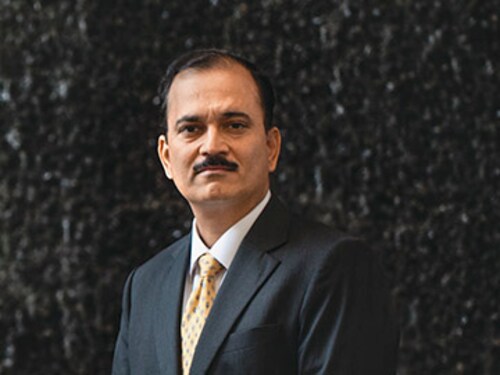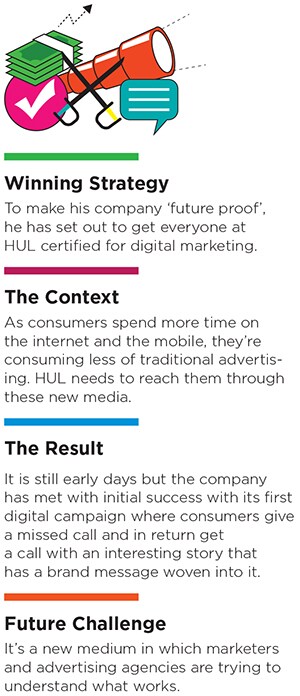HUL's Nitin Paranjpe: How to Make Friends and Win
HUL’s Nitin Paranjpe is rewiring his organisation for the digital marketing era. And he’s leading from the front


Award: Best CEO MNC
Name: Nitin Paranjpe, CEO, HUL
Age: 49
Why He Won: For resurrecting HUL’s position as a premium multinational, after almost a decade in the wilderness. And for bringing the focus back on execution and profitable growth with a significant expansion of its distribution system.
When I met Nitin Paranjpe early in December last year, he very clinically dissected the difference between a successful entrepreneur and a manager. He told me, “The only difference is the relationship between ambition and resources.”
It was something, he said, that was drilled into his head by legendary management thinker CK Prahalad, who was brought in by the board in 1999 to mentor a few people destined for larger roles at Hindustan Unilever (HUL). “Managers,” Paranjpe learnt from Prahalad, “have a mindset... where ambition (A) equals resources (R), a steady state condition. There are no entrepreneurs who start off believing A=R. They have virtually no resources, but dream big.”
To understand how the insight Prahalad offered played out during the course of Paranjpe’s career, it is important to put a few numbers into perspective. Since the time he took over as CEO four years ago, sales jumped 45 percent to Rs 22,800 crore growth in profits averaged an eye-popping 25 percent the company’s market capitalisation zoomed 60 percent to over Rs 1.14 lakh crore and in January this year, the Nielsen Campus Track reported HUL had reclaimed its spot as the most preferred employer among B-School grads.
Compare this to what things were like when Paranjpe was offered the corner office four years ago. He was 44 then and the youngest chief executive HUL ever had. Growth in sales and profits were stagnant. Its stock had stayed around Rs 200 for eight years. The company had lost its position as the recruiter of choice at premier B-Schools. For an entity that once used to be known as the training ground for future CEOs in the country, this was as humiliating as it could get.
After architecting a now well-documented and dramatic turnaround, it is easy therefore to imagine a smug 49-year-old man on the lecture circuit telling people how things ought to be done. What you have instead is a man back to school. Why? Because by his own admission, he couldn’t understand the brave new world his children inhabit. What the hell are they doing spending all their time on social networking sites like Facebook and Twitter? In any case, what are these places all about?
As he looked around, he realised his kids aren’t the only ones who live in this world. There are 121 million internet users in the country—the third largest user base in the world. Not surprisingly, their media consumption patterns are changing dramatically. It is only a matter of time, he figured, before their numbers overtake that of those who consume media on print and television. If that be true, he argued, HUL would have to work at moulding itself as the largest digital marketing firm in the country.
“Most people say we either need to do short-term or long-term. I say we have to run the business with a bifocal lens. Part of it is looking at this week, this month and this quarter and the other part is how do I shape this business and make it ‘future-proof’ five years from today. Both have to be done,” he argues.
While dealing with the short term part of the business is now easy for him, it is the long term he was beginning to get paranoid about. If HUL had to maintain the lead he had managed to create in his four years at the helm, both the company and he would have to change. “At a consumer goods company, if the consumer is moving in a certain direction, how can the head of the company say he doesn’t get it?” he asks rhetorically.
So, he got himself a ‘reverse mentor’. A young 25-year-old at the firm was put in charge of tutoring the CEO on how to navigate the social media. How do you tag a person on Facebook? How do you write on somebody’s wall? How do you tweet? Most people at his level lead seminars. But he figured if he had to participate in the world his children were now a part of, he’d have to “go back to school” and attend digital workshops led by his brand managers, read the materials they insisted he read, and submit assignments they asked him to complete. When we last checked, he had 251 friends on Facebook on Twitter though, he remains a passive participant.
Even as he embarked on this personal exercise, he initiated discussions with the management committee, an eight-member body that runs the day-to-day affairs of the company. At these meetings, he communicated how paranoid he was that HUL maintains its lead in the market place.
Marketing Director Hemant Bakshi says Paranjpe was clear the strategies that helped them win so far may not necessarily be what will help them win tomorrow. “Because the skills and capabilities with which I grew up as a marketer are dramatically different from the skills and capabilities needed in the future,” Paranjpe explained.
These arguments eventually won over the other members on the committee. Some chose the path of reverse mentoring like Paranjpe others struck out on their own. On his part, Paranjpe reckoned it was time he dived headlong into uncharted waters. He moved on to plan his own online advertising campaigns, allocating budgets for them and seeing how the efficacy of such ads among audiences is measured. That, in a nutshell, is how HUL got into the digital marketing journey.
That done, he got into an agreement with Google to train the 100 senior most managers at HUL in the ways of the digital world by the end of this year. ‘Digitally certified’ is what they’re called. Eventually, he wants every employee in the company to be digitally certified. Says Leena Nair, executive director, human resources, “You may question why somebody in the supply chain needs to be digitally certified. But Nitin was clear that every employee in the firm has to be.”
For now though, the company is working hard at learning the new rules of this medium. The hardest one to absorb is that advertising cannot be intrusive and interruptive the way television advertising is. Instead it has to engage and integrate with whatever the customer is doing at any given moment. For instance, pop up ads on web pages are intrusive and drive people away.“So, all the work we are doing on digital—the certification process, the reverse mentoring—is to say this is a new medium and until we get educated in its ways, we won’t be able to create interesting options for our consumers,” says Bakshi.
Advertising agencies have been roped in as well to help navigate this landscape because nobody knows which way it is headed.
All of the work the team at HUL is putting in is generating new lessons for their marketing teams. To cite just one instance, they quickly figured that the rules of engaging with consumers on the internet and mobile phones are very different from the worlds they grew up in. But there was a paradox.
While the younger employees understood this world, the purse strings were controlled by older people who were not always on the same wavelength. Simply put, the bosses lacked the judgement to decide if allocating resources to digital media would be wise.
That is also the reason why HUL’s marketing department is going deeper to understand what works in this world. On his part, Bakshi has set aside a corpus of Rs 10 crore as a ‘Digital Experimentation Fund’.
The aim is to encourage employees to come up with interesting ideas. If it passes scrutiny, money from this corpus will be used to fund the idea and figure out if it works. “If you have to fail, fail early, before it becomes too expensive. If you have to fail and not make the same mistake again, then the failure is well worth it. But we don’t encourage failure. I encourage winning,” says Paranjpe. The first sets of pitches are expected to come in later this month. Every year, Paranjpe intends to double the resources allocated for projects like these. “It doesn’t matter how much it costs. This company can afford it,” he says.
The seeds to this corpus were planted when the senior team at HUL lent an ear to an unlikely quarter. Sometime last year a brand manager at Wheel, a detergent powder brand in the company’s portfolio, proposed what came to be known within the company as the ‘missed call’ campaign. The manager had observed that many Indians avoid placing a call on their cellphones because it cost them money. Instead, they place a call to the person they intend to speak to and hang up before the call is received. Inevitably, they would get called back. What if, the brand manager suggested, all sachets of Wheel had a message printed on them: “Missed call dijiye, muskurate rahiye [Give a missed call and stay smiling].” The message was accompanied by a number.
The idea was that if somebody indeed placed a ‘missed call’, the company would call back and regale the individual with an interesting anecdote that contained a message around the Wheel brand. From a marketer’s perspective, it sounded like an interesting proposition: Permission marketing. The idea was given the go-ahead and the outcome astonished the bosses. In three months, they received 15 million calls.
The numbers reinforced Paranjpe’s belief that digital will cause a tectonic shift in the years to come and he had to be prepared for it. The Rs 100 crore HUL now spends on digital marketing, may look like chump change in the future. (The company has Rs 2,634 crore at its disposal.)
That said, Paranjpe also knows throwing money at the problem, just because HUL has enough of it, isn’t good enough. “So you either starve resources or create an ambition that is greater than the resources you have on hand. The bigger the gap, the better it is…because there the trick is, you suspend all room for rational dialogue.”
Which is why, Paranjpe is insisting HUL becomes the biggest and most successful digital marketing company in a world where the rules are still unclear. As ambitions go, it is an incredibly tough one for a consumer marketing company. He knows that in spite of all the resources the firm has in terms of money, the only resource that will matter the most is ingenuity. Ingenuity of that kind cannot be drilled down from the top. Instead, it will have to be stoked from all quarters until everybody goes ballistic and all room for rational dialogue is closed.
First Published: Oct 08, 2012, 06:16
Subscribe Now